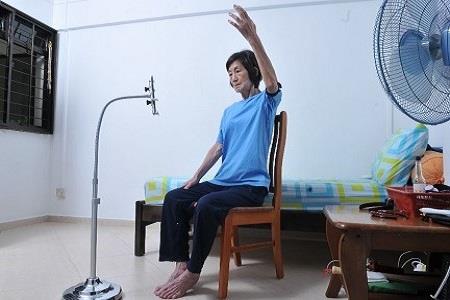Despite knowing that rehabilitation is helpful for recovery, many stroke patients do not continue with it after discharge. Inconvenience, high costs and difficulty getting to the rehabilitation centre without a caregiver were the main reasons why they
stopped going for rehabilitation. This was according to initial studies led by Dr Gerald Koh, Associate Professor at Saw Swee Hock School of Public Health at National University of Singapore (NUS). “The very reason why (they) needed rehabilitation
is the very reason why (they) can’t get to the day rehab centre three times a week,” Dr Koh said.
To address this issue, Dr Koh and his team developed a home-based tele-rehabilitation solution called Smart Health TeleRehab. From the comfort of their homes, patients first open the Smart Health TeleRehab app on an iPad and strap on neck and
limb sensors. They can then start performing exercises prescribed by the therapists by following video demonstrations. The app is designed to also have a counter to keep track of the number of repetitions completed and coloured bars to indicate if
the patient has achieved the desired exercise angle. The exercise sessions are automatically recorded and are sent together with tabulated exercise charts to the therapists to review.
The Smart Health TeleRehab is a nationwide pilot programme involving 14 institutions, of which NTUC Health and TOUCH Home Care have already implemented such sessions since February 2017. It comes two and a half years after clinical trials were
conducted with Ang Mo Kio Thye Hua Kwan Hospital and Singapore General Hospital, through funding from Temasek Foundation Innovates’ Singapore Millennium Foundation Research Grant Programme. An estimated 1,000 patients are expected to benefit from
this pilot programme by the end of 2018.
For TOUCH Home Care, the price per tele-rehab session is still the same as a home visit at S$18. Physiotherapist, Vivian Lim said that as the patient is able to carry out the exercises more frequently and at their own time, the hope is that he
or she will recover faster and the overall therapy sessions would be reduced. She has been able to see six to seven patients a day, up from five patients which she could previously manage. She added that “we are not taking ourselves out of the equation…
I think that (this) model of care will supplement and actually enhance recovery.”
FIND OUT MORE
About Singapore Millennium Foundation Research Grant Programme
The Singapore Millennium Foundation (SMF) Research Grant Programme promotes research in niche and under-funded areas through funding research projects in the areas of Learning & Pedagogy, Palliative Care, and Food Supply Resiliency &
Bio-Mimetics. The SMF Research Grant Programme is currently managed by Temasek Foundation Innovates.
About Temasek Foundation Innovates
Temasek Foundation Innovates is one of the six non-profit philanthropic organisations set up by Temasek and sponsored through Temasek Trust.
Temasek Foundation Innovates funds and supports programmes that focus on developing practical solutions for a better life through research and innovation. It aims to strengthen research capabilities by nurturing talents, as well as by encouraging
multi-disciplinary programmes and inter-agency collaboration for collective capabilities.
Did you know?
Stroke is one of the leading causes of long-term physical disability in Singapore. A stroke occurs when blood supply to part of the brain is interrupted, causing that part of the brain to rapidly lose function. As a result, the part of the body
controlled by that portion of the brain does not function normally. Physical therapy is the foundation of stroke recovery. Appropriate exercise does not only help a stroke survivor recover from his disabilities, but can also cut stroke risk. Researchers
found that as exercise levels increases, the risk of suffering a stroke decreases. Those who exercised the most have half the risk of those who are least active. Walking, bending and stretching are forms of exercise that can help strengthen the body
and keep it flexible.
IMPACT HUB
Doing Physiotherapy Exercises from Home through Tele-Rehabilitation
25 Jan 2018

